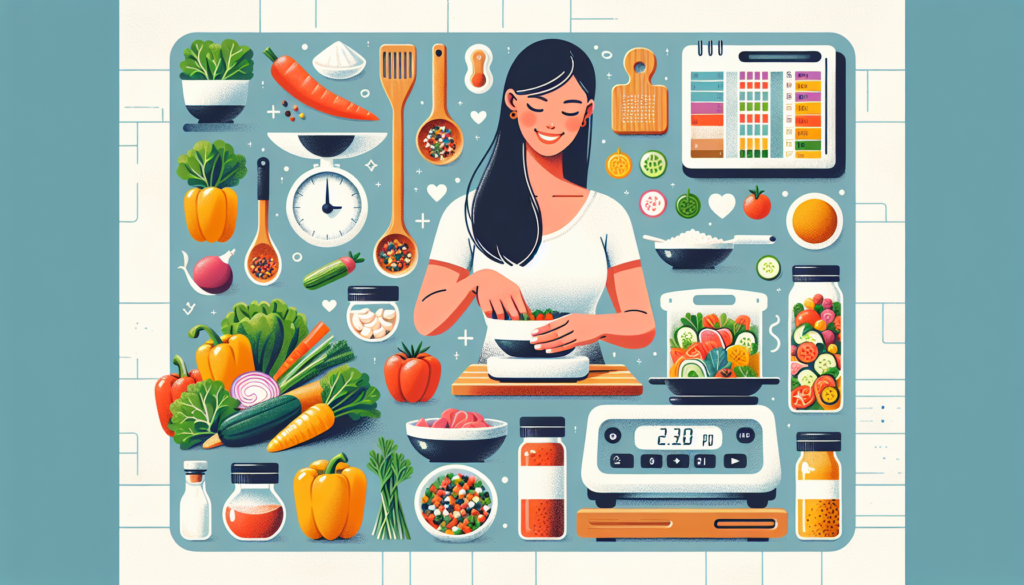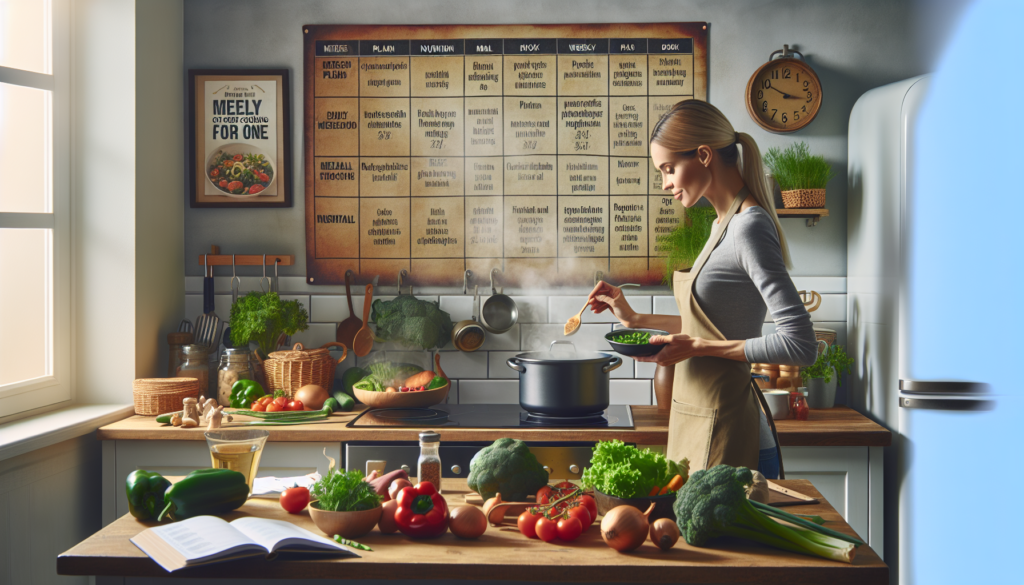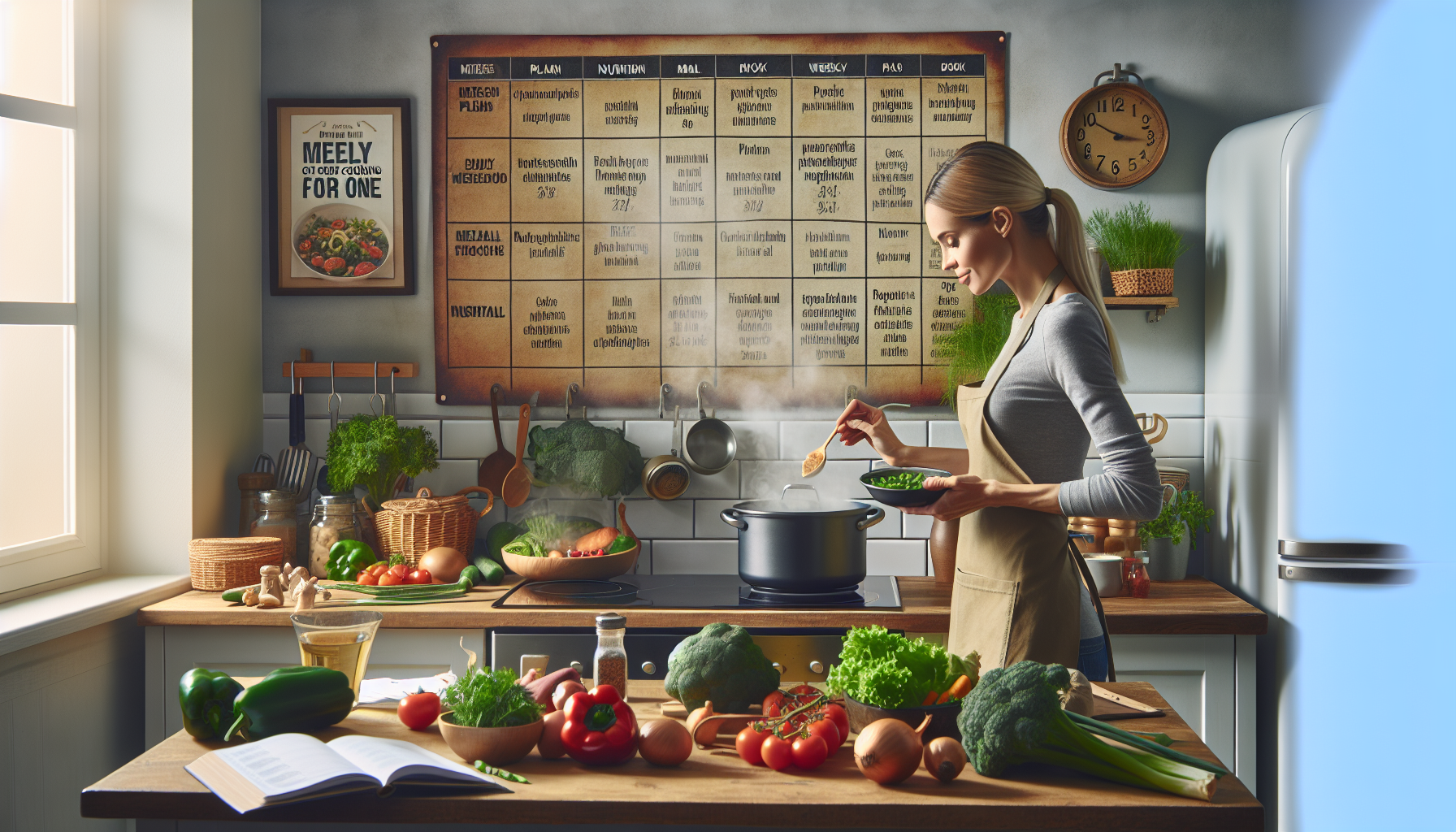If you find yourself embarking on a journey of solo cooking, it’s essential to equip yourself with a few key techniques to ensure you maintain a healthy and enjoyable culinary experience. In this article, we will explore some effective strategies that will help you create delicious and nutritious meals, all while embracing the joy of solo cooking. So grab your apron, sharpen your knives, and get ready to discover the secrets to mastering the art of healthy solo cooking.
Preparation Techniques
When it comes to healthy solo cooking, preparation is key. By taking the time to plan your meals, create a shopping list, and prep your ingredients, you set yourself up for success in the kitchen.
Meal Planning
Meal planning is an essential technique for healthy solo cooking. By taking the time to plan your meals for the week, you can ensure that you have nutritious and delicious options on hand. Start by making a list of your favorite healthy recipes and then schedule them out for the week. Consider incorporating a variety of proteins, carbohydrates, and vegetables to create balanced meals.
Shopping List Creation
Creating a shopping list is an important step in healthy solo cooking. Before heading to the grocery store, take a look at your meal plan and make a list of all the ingredients you’ll need. This will help you stay organized and avoid impulse buys. Additionally, be sure to check your pantry and fridge to see what you already have on hand, so you don’t end up buying duplicates.
Ingredient Prepping
Ingredient prepping can save you a significant amount of time in the kitchen. Take some time at the beginning of the week to wash and chop your vegetables, portion out your proteins, and cook any grains or legumes you’ll be using. This way, when it’s time to cook, you can simply grab the prepped ingredients and start cooking. Plus, having ingredients ready to go can make it easier to stick to your healthy eating goals when you’re short on time.
Cooking Techniques
Knowing a variety of cooking techniques can help you create delicious and healthy meals. Here are some key techniques to have in your cooking repertoire:
Sauteing
Sauteing involves cooking food quickly in a small amount of oil or fat over high heat. It’s a great technique for cooking vegetables, meats, and seafood. To saute, heat a pan with a small amount of oil or fat, add your ingredients, and cook until they’re cooked through and slightly browned.
Stir-frying
Similar to sauteing, stir-frying involves cooking food quickly over high heat in a small amount of oil. This technique is commonly used in Asian cuisines and is a great way to cook vegetables and thinly sliced meats. The key to stir-frying is to keep the ingredients moving constantly to ensure even cooking.
Boiling
Boiling is a simple cooking technique that involves submerging food in a liquid and heating it until it reaches its boiling point. This technique is commonly used for cooking grains, pasta, and potatoes. It’s important to keep an eye on the food while it’s boiling to prevent overcooking.
Steaming
Steaming is a healthy cooking technique that involves cooking food over, but not in contact with, boiling water. This gentle cooking method helps to retain the food’s natural flavors and nutrients. It’s perfect for cooking vegetables, fish, and dumplings.
Grilling
Grilling is a popular cooking technique, especially during the summer months. Whether you’re using a gas grill, charcoal grill, or stovetop grill pan, grilling can add delicious flavor to your food without the need for excess oil. It’s great for cooking lean proteins like chicken, fish, and vegetables.
Baking
Baking is a fantastic cooking technique for a wide variety of dishes. It involves cooking food in an oven using dry heat. Baking is commonly used for casseroles, roasted meats, and baked goods. It’s a versatile technique that allows for even cooking and the development of delicious flavors.
Roasting
Roasting is a dry cooking technique that involves cooking food in an oven at a high temperature. It’s a great technique for cooking vegetables, meats, and poultry. Roasting helps to caramelize the natural sugars in the food, resulting in delicious flavors and textures.
Broiling
Broiling is a cooking technique that involves cooking food using direct heat from above. It’s similar to grilling but without the need for an outdoor grill. Broiling is perfect for cooking thin cuts of meat, fish, and vegetables. Be sure to keep a close eye on the food while broiling to prevent burning.
Poaching
Poaching is a gentle cooking technique that involves cooking food in a liquid at a low temperature. It’s commonly used for cooking eggs, fish, and chicken. Poaching helps to retain moisture and create tender, flavorful dishes.
Simmering
Simmering is a slow and gentle cooking technique that involves cooking food in a liquid just below its boiling point. It’s great for soups, stews, and braises. Simmering allows flavors to develop and meld together, resulting in delicious and comforting dishes.

Flavor Enhancement Techniques
Adding flavor to your meals is essential for creating enjoyable and satisfying dishes. Here are some techniques to enhance the flavors of your meals:
Marinating
Marinating is a technique that involves soaking food, typically in a mixture of oil, acid (such as vinegar or citrus juice), and spices, to add flavor and tenderize the meat. Marinating is commonly used for poultry, seafood, and meats. The longer you marinate, the more flavor will be imparted.
Using Fresh Herbs and Spices
Fresh herbs and spices are a great way to add flavor to your meals without adding excess calories or sodium. Experiment with different combinations and quantities to find your favorite flavor combinations. Some common herbs and spices that can elevate your dishes include basil, thyme, rosemary, cumin, paprika, and garlic.
Making Homemade Sauces and Dressings
Store-bought sauces and dressings often contain added sugars, unhealthy fats, and preservatives. Making your own sauces and dressings allows you to control the ingredients and flavors. Experiment with different combinations of ingredients, such as Greek yogurt, citrus juice, vinegar, herbs, and spices, to create healthy and flavorful options.
Healthy Ingredient Substitutions
Making healthy ingredient substitutions can help you reduce the amount of unhealthy fats, refined grains, and added sugars in your meals. Here are some substitutions to consider:
Replacing unhealthy fats with healthier alternatives
Instead of using butter or margarine, opt for healthier fats like olive oil, avocado oil, or coconut oil. These fats are rich in monounsaturated fats and can help improve heart health.
Substituting refined grains with whole grains
Swap out refined grains like white rice, pasta, and bread with whole grains like brown rice, quinoa, whole wheat pasta, and whole grain bread. Whole grains are higher in fiber and nutrients, and provide sustained energy throughout the day.
Using natural sweeteners
Instead of using refined sugars, experiment with natural sweeteners like honey, maple syrup, and dates. These sweeteners add a natural sweetness to your dishes while providing some additional nutrients.
Opting for lean proteins
Choose lean sources of protein, such as chicken breast, turkey, fish, tofu, and legumes, instead of fatty cuts of meat. Lean proteins are lower in saturated fat and can help promote heart health.

Mindful Eating Techniques
In addition to cooking techniques, it’s important to practice mindful eating to create a healthy relationship with food. Here are some techniques to consider:
Portion Control
Pay attention to your portion sizes to avoid overeating. Use measuring cups, a food scale, or your hand as a guide for portion sizes. It’s also helpful to eat slowly and savor each bite to give your body time to register fullness.
Making Healthy Food Choices
Choose nutrient-dense foods that are rich in vitamins, minerals, and fiber. Opt for whole foods like fruits, vegetables, whole grains, lean proteins, and healthy fats. These foods provide essential nutrients without the added calories and unhealthy additives.
Avoiding Emotional Eating
Instead of turning to food as a source of comfort or stress relief, find alternative ways to manage your emotions. Engage in activities like exercise, reading, painting, or spending time with loved ones to distract yourself from emotional eating triggers.
Proper Storage Techniques
Properly storing your ingredients and leftovers can help extend their shelf life and reduce food waste. Here are some storage techniques to keep in mind:
Refrigeration
Many ingredients, such as fresh produce, dairy products, and cooked leftovers, need to be stored in the refrigerator to maintain their freshness and prevent spoilage. Be sure to properly wrap or store these items in airtight containers to prevent cross-contamination and maintain optimal freshness.
Freezing
Freezing is a great way to preserve food and prevent waste. Many ingredients can be frozen, including meat, poultry, seafood, bread, and fruits and vegetables. When freezing, be sure to use freezer-safe containers or packaging to protect against freezer burn and maintain quality.
Meal Prepping for Portion Control
Meal prepping is a technique that involves preparing meals in advance to have them ready for the week. For portion control, consider portioning out your meals into individual containers to avoid overeating. This can also save you time during busy weekdays when you may not have time to cook.
Efficiency Techniques
To make healthy solo cooking more efficient, consider using these techniques:
One-Pot Meals
One-pot meals are perfect for minimizing cleanup and saving time in the kitchen. Choose recipes that allow you to cook your protein, grains, and vegetables all in one pot or pan. This way, you can have a nutritious and delicious meal without spending too much time on cleanup.
Sheet Pan Dinners
Sheet pan dinners are another great option for easy and efficient cooking. Simply place your protein, vegetables, and seasoning on a sheet pan and roast it in the oven. This technique allows for hands-off cooking and minimal cleanup.
Kitchen Gadgets and Tools
Invest in kitchen gadgets and tools that can make your solo cooking experience more efficient. Some useful tools to consider include a slow cooker, Instant Pot, food processor, and immersion blender. These tools can help you save time and effort in the kitchen.
Time-Saving Techniques
When cooking for one, time is often a precious resource. Here are some time-saving techniques to help you make the most of your cooking:
Batch Cooking
Batch cooking is a technique that involves cooking larger quantities of food and portioning them out for future meals. By cooking in bulk, you can save time and have meals ready to go for busy days. Simply divide the cooked food into individual containers and store them in the fridge or freezer for later use.
Pre-cut and Pre-packaged Ingredients
Take advantage of pre-cut and pre-packaged ingredients to save time in the kitchen. Many grocery stores offer pre-cut vegetables, packaged salad greens, and pre-cooked proteins like grilled chicken or roasted turkey slices. These convenient options can help cut down on prep time and make cooking a breeze.
Using Leftovers Creatively
Don’t let leftovers go to waste! Get creative with how you use them to create new and exciting dishes. For example, leftover roasted chicken can be used to make a delicious chicken salad or added to a stir-fry. By repurposing your leftovers, you can save time and reduce food waste.
Balanced Meal Planning
A balanced meal plan is essential for meeting your nutritional needs and maintaining a healthy lifestyle. Here’s how to create balanced meals:
Incorporating Vegetables and Fruits
Make sure to include a variety of vegetables and fruits in your meals to ensure you’re getting a wide range of vitamins, minerals, and fiber. Aim to fill half your plate with vegetables and include fruit as a healthy snack or dessert option.
Including Protein, Carbohydrates, and Healthy Fats
Every meal should include a source of protein, carbohydrates, and healthy fats to keep you satisfied and provide the necessary nutrients. For protein, choose lean options like chicken, fish, tofu, or beans. For carbohydrates, opt for whole grains like quinoa or brown rice. And for healthy fats, include foods like avocados, nuts, and olive oil.
Avoiding Excess Sodium and Added Sugars
Limit your intake of sodium by choosing fresh ingredients and avoiding processed foods. Use herbs, spices, and other flavor enhancers instead of salt to add taste to your meals. Additionally, be mindful of added sugars in packaged foods and opt for natural sweeteners when possible.
Personalization Techniques
Make your healthy solo cooking experience more enjoyable by personalizing your meals to your preferences. Here are some techniques to consider:
Adapting Recipes to Dietary Restrictions
If you have dietary restrictions or allergies, don’t let that hold you back from enjoying delicious meals. Experiment with adapting recipes to meet your needs. For example, if you’re gluten-free, substitute gluten-free grains for wheat-based ones. If you’re lactose intolerant, explore dairy-free alternatives.
Experimenting with Flavors and Cuisines
Don’t be afraid to step out of your comfort zone and experiment with flavors and cuisines. Try new spices, herbs, or sauces to add excitement to your meals. Explore different cultural cuisines and incorporate new ingredients into your cooking. This can make solo cooking more fun and adventurous.
Adding Variety to Meals
Eating the same meals over and over again can become monotonous. Keep things interesting by adding variety to your meals. Try new recipes, swap out ingredients, or explore different cooking techniques. By continuously introducing new flavors and dishes into your routine, you’ll keep your taste buds satisfied and make healthy eating more enjoyable.
By incorporating these key techniques into your healthy solo cooking routine, you can create delicious and nutritious meals that will nourish your body and satisfy your taste buds. With proper preparation, cooking techniques, and mindful eating practices, you’ll be well on your way to becoming a confident and efficient home cook. So grab your apron and get ready to embark on a journey of culinary exploration and self-care through healthy solo cooking.
